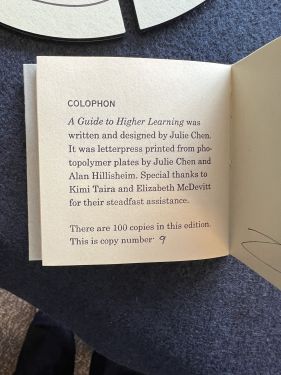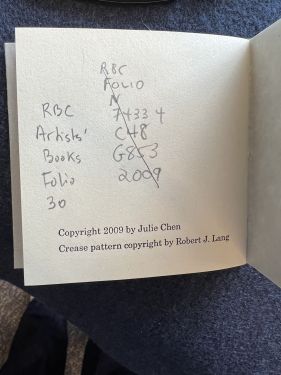A Guide to Higher Learning: Difference between revisions
| Line 4: | Line 4: | ||
== Author Biography == | == Author Biography == | ||
[[File:Julie chen photo.jpeg||left|thumb]] | |||
Julie Chen is an influential American book artist and educator, celebrated for her innovative contributions to the field of book arts. Born and raised in the United States, Chen completed a degree in printmaking from the University of California, Berkeley, which sparked her interest in the language, materials, and equipment of book arts. <ref name ="bio"> “Chen, Julie.” Oxford University Press eBooks, 2014, https://doi.org/10.1093/benz/9780199773787.article.b2265337. </ref> This interest led her to pursue further studies in the Book Arts program at Mills College, where she later became a faculty member teaching Book Arts.<ref name="bio" /> | Julie Chen is an influential American book artist and educator, celebrated for her innovative contributions to the field of book arts. Born and raised in the United States, Chen completed a degree in printmaking from the University of California, Berkeley, which sparked her interest in the language, materials, and equipment of book arts. <ref name ="bio"> “Chen, Julie.” Oxford University Press eBooks, 2014, https://doi.org/10.1093/benz/9780199773787.article.b2265337. </ref> This interest led her to pursue further studies in the Book Arts program at Mills College, where she later became a faculty member teaching Book Arts.<ref name="bio" /> | ||
Revision as of 20:37, 4 May 2024

A Guide to Higher Learning is an artists' book created by American book artist Julie Chen in 2009. It examines the experiential process of acquiring knowledge, on both academic and personal levels. The piece itself is comprised of 8 sections of rigid square pages that are hinged together in unexpected ways, giving the reader a physical reading experience that mirrors the complex meaning of the content.[1] The book in its fully unfolded form (to the right) reveals an intricate and fascinating visual pattern of information. Through skillfully combining traditional bookmaking craftsmanship with interactive and kinetic elements, it engage readers in a tactile exploration of mathematical concepts and intellectual curiosity.
Author Biography
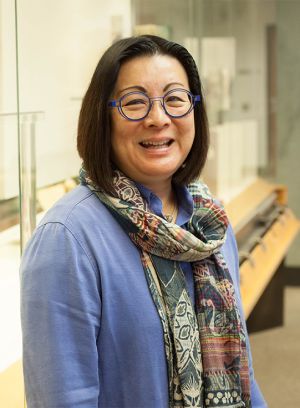
Julie Chen is an influential American book artist and educator, celebrated for her innovative contributions to the field of book arts. Born and raised in the United States, Chen completed a degree in printmaking from the University of California, Berkeley, which sparked her interest in the language, materials, and equipment of book arts. [2] This interest led her to pursue further studies in the Book Arts program at Mills College, where she later became a faculty member teaching Book Arts.[2]
In 1987, Julie Chen founded Flying Fish Press in Berkeley, California. [2] The press focuses on designing and producing limited edition artists' books that integrate the crafts of letterpress printing and hand bookbinding with modern technologies like laser cutting and digital printing.[3] Her works are known for their meticulous attention to craft, intricate structural designs, and the meaningful interplay of text and image. Chen's books are unique three-dimensional art pieces that challenge traditional notions of what a book can be, emphasizing interactivity and sensory engagement.
Julie Chen’s books are held in numerous prestigious collections worldwide, including the Library of Congress in Washington, D.C., the Victoria and Albert Museum in London, and the Sir George Grey Special Collections in Auckland, New Zealand. In 2009, she was featured in the PBS television series "Craft in America," highlighting her significant role in the craft movement. [2]
Historical Context
Julie Chen's "A Guide to Higher Learning," created in 2009, stands as a pivotal work in the realm of artists' books, reflecting the late 20th and early 21st-century fascination with the intersections of technology, information dissemination, and traditional bookmaking. [4] Chen is celebrated for her innovative approach to book arts, crafting books that are not only vehicles for text and information but are also interactive art pieces. These innovations not only provide a visual and tactile experience but also bridge the gap between traditional craftsmanship and contemporary artistic expression.
The book exemplifies the evolution of book forms and functions within contemporary art. Each copy of Chen’s book is a unique artwork, highlighting issues of copyright in an era dominated by mass production and digital reproduction. [5]
The materials and detailed manual processes involved in the creation of "A Guide to Higher Learning" reflect a deliberate choice that enhances the book’s narrative and conceptual themes, focusing on learning and exploration. Chen's work typically circulates among special collections, libraries, and collectors, particularly appealing to enthusiasts and scholars of book arts interested in the synergy of text, art, and design.
Given its limited distribution and the niche audience it attracts, evidence of its readership is primarily visible through its presence in academic discussions, exhibitions dedicated to book arts, and inclusion in specialized collections. These factors collectively demonstrate its value and impact on its audience, reinforcing its significant place in the history of artists' books and its influence on the ongoing dialogue around the evolution of reading and interaction with multimedia formats.
Material Analysis
Substrate
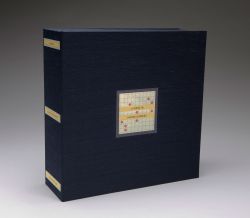

The book actually includes four pieces: a cloth covered clamshell box, the book itself (initially found in its unfolded state), a small Answer Book integrated within the book, and a viewing cloth. For its technical details, the box has dimensions 11.75” by 11.75” by 3.75”, the book is 11” by 11” by 3.125” in its unfolded state, and the Answer Book is 8 x 8 cm. After unfolding the book onto the viewing cloth, it encompasses a 31 square.[6]
Julie Chen's A Guide to Higher Learning is crafted using several high quality materials that are characteristic of her meticulous approach to bookmaking. The book is letterpress printed using photopolymer plates on various types of paper, museum board, and is complemented with elements of plexiglass and tyvek. [1] These materials are chosen for their durability and aesthetic qualities, allowing for complex folding and unfolding mechanisms that are integral to the reader’s interaction with the book. Between the hinges are magnetic components so that the pages fold on top of each other in an orderly fashion.
The use of diverse substrates and materials not only enhances the visual and tactile aspects of the book but also aligns with Chen's emphasis on the book as a physical and interactive object.
Platform: Artists' Book
Artists' books are works of art realized in the form of a book, often published in small editions or as unique objects known as "book objects." These works transcend traditional books by prioritizing artistic intent, often integrating text, image, and inventive formats to create a cohesive artistic expression. Unlike conventional books where content predominates, artists' books consider the medium itself as a crucial component of the artistic message, challenging conventional boundaries between books and art[7].
These creations offer a more intimate and interactive experience by reimagining the structure and presentation of books. Artists like Julie Chen are notable for their contributions to this medium, employing complex mechanisms such as pop-ups and elaborate folds, and using diverse materials that engage the reader in physical interactions, thus enriching the reading experience [8].
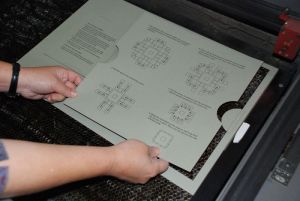
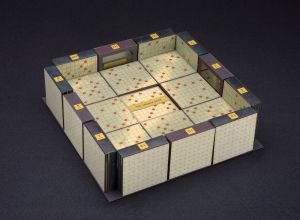
To read the book the whole assembly must be lifted from the box and placed on the center of the cloth so there is sufficient space for the book to be opened up. Each square page is numbered clockwise. The reader thus begins with page 1 on the right, opening each flap as the arrows suggest, and continues around the structure clockwise through page 12. It follows a geometric spiral / circular pattern which mirrors the content of the book. After doing this, the reader is supposed to look at the answer book which explains the mathematical ideas, the origami patterns of Robert J. Lang, and the Ulam spiral [9] at the center of the book.
Marginalia / Annotations
At the Colophon (last page with text), Julie wrote which copy of this edition of A Guide to Higher Learning this book is (#9). On the page to the right of the #9, she wrote her signature. Both are written using the same ink from a pen. These annotations confirm that Julie Chen used her own hands on this book and signals the context of where this book lies in her portfolio.
There are also annotations written by someone most likely at Kislak cataloging the book. It writes “RBC Artists’ Books Folio 30”, but next to it was indecipherable letters (ex: N74334...) that were crossed out. It's reasonable to assume that this was also meant to catalogue.
-
Copy #
-
Her Signature
-
Kislak Catalogue
Mathematical Analysis
Structural Design and Mathematical Themes: The book consists of rigid square pages that unfold in unexpected ways, revealing four major branches of mathematics: Analysis, Geometry, Abstract Algebra, and Number Theory. Each section is meticulously designed to not only display complex mathematical equations and textual elements but also to integrate origami crease fold patterns, enhancing the visual and interactive experience. This design mirrors the complexity and layered nature of acquiring mathematical knowledge, offering a physical representation of the learning process.
Interactive Learning Experience: Chen’s work emphasizes the kinesthetic aspect of learning. Readers manipulate the pages, folding and unfolding, to navigate through intricate mathematical discussions. This interaction is not just about reading or viewing but involves physical engagement that complements the intellectual exploration of mathematical concepts.
Mathematical Content Exploration: Each quadrant of the book delves into significant mathematical theories and equations:
- The Analysis section (Pages 1-3) presents fundamental mathematical relations, such as variations of the Betafunction, setting the stage for exploring the concept of unity in mathematics.
- In the Geometry loop (Pages 4-6), readers encounter spatial calculations like Heron's Formula in both Euclidean and hyperbolic geometries, illustrating the evolution and relational dynamics of geometric spaces.
- The Abstract Algebra quadrant (Pages 7-9) , better characterized by its linear algebraic focus, explores matrix operations and tensor products, emphasizing the foundational unity and identity in algebra.
- Number Theory (Pages 10-12) explores deep mathematical conjectures, including the Riemann hypothesis, highlighting ongoing mathematical inquiries and the elusive nature of proof in mathematics.
Philosophical and Educational Implications: The book’s design and content encourage a philosophical reflection on the nature of knowledge and learning. Mathematical equations and concepts serve as proxies for exploring broader philosophical questions about understanding and the limits of knowledge. This makes the book particularly appealing not just to mathematicians but also to educators, philosophers, and anyone intrigued by the interplay between form, function, and content in learning.
Significance
Conceptual Depth: The content and design of "A Guide to Higher Learning" delve into themes of knowledge, discovery, and the pursuit of understanding. Chen uses the form of the book to metaphorically explore these concepts, inviting readers to engage physically and intellectually with the material. This conceptual depth adds a layer of significance as it reflects on the nature of learning and the search for meaning through the structure of the book itself.
Artists' Books as Art Form: By pushing the boundaries of book design and integrating fine art practices, Chen's work contributes significantly to the recognition of artists' books as a legitimate and standalone art form. "A Guide to Higher Learning" serves as a prime example of how artists' books can be both literary and visual artworks, deserving of study and appreciation in the same way as paintings or sculptures.
Educational and Reflective Tool: The book encourages reflection on the process of learning itself, making it a powerful educational tool. It prompts readers to consider the ways in which knowledge is constructed and understood. Some of the equations are so complex that even Ivy League math majors (not referring to myself) can't figure them out without help from more knowledgeable mentors. This reflective quality ensures that the book is not only an object of art but also a medium for education and philosophical inquiry.
Collectibility and Impact on Libraries and Collectors: Due to its unique characteristics and limited production of 100 copies, works like "A Guide to Higher Learning" are highly valued by collectors and libraries, particularly those specializing in rare books and book arts like Kislak. Its presence in such collections helps to promote and preserve the art of bookmaking and ensures that innovative approaches to the book as an art form continue to be accessible for future generations.
References
- ↑ 1.0 1.1 A Guide to Higher Learning – Julie Chen | Flying Fish Press. flyingfishpress.com/portfolio-item/a-guide-to-higher-learning.
- ↑ 2.0 2.1 2.2 2.3 “Chen, Julie.” Oxford University Press eBooks, 2014, https://doi.org/10.1093/benz/9780199773787.article.b2265337.
- ↑ About – Julie Chen | Flying Fish Press. flyingfishpress.com/about.
- ↑ Blog, Larb. “The Book’s Body: Talking to Amaranth Borsuk - BLARB.” BLARB, 19 June 2018, blog.lareviewofbooks.org/interviews/books-body-talking-amaranth-borsuk.
- ↑ Pistorius, Tana, and Odirachukwu Stephen Mwim. “The Impact of Digital Copyright Law and Policy on Access to Knowledge and Learning.” Reading &Writing/Reading & Writing, vol. 10, no. 1, June 2019, https://doi.org/10.4102/rw.v10i1.196.
- ↑ Rubis, Oksana M., and Kathleen M. Clark. “A Guide to Higher Learning by Julie Chen, Flying Fish Press, Oakland, 2009.” the College Mathematics Journal/the College Mathematics Journal, vol. 51, no. 5, Nov. 2020, pp. 378–84. https://doi.org/10.1080/07468342.2020.1830658.
- ↑ Drucker, Johanna. The Century of Artists’ Books. 2004.
- ↑ Klima, Stefan. Artists Books: A Critical Survey of the Literature. 1998.
- ↑ Orłowski, Arkadiusz, and Leszek J. Chmielewski. “Ulam Spiral and Prime-Rich Polynomials.” Lecture notes in computer science, 2018, pp. 522–33. https://doi.org/10.1007/978-3-030-00692-1_45.
